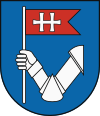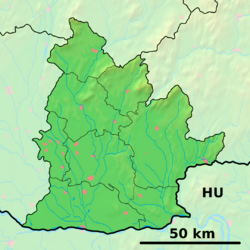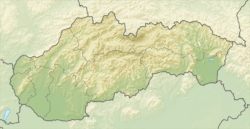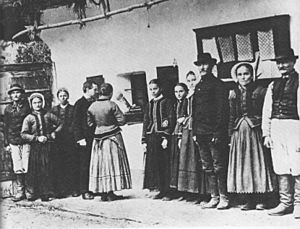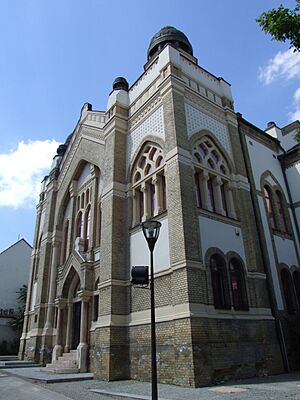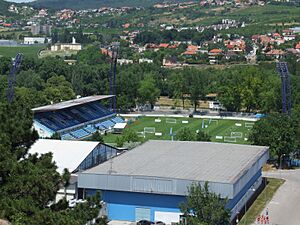Nitra facts for kids
Quick facts for kids
Nitra
|
|||
|---|---|---|---|
|
City
|
|||
|
From the top, Panoramic view of Nitra, St. Emmeram's Cathedral located within the Nitra Castle precinct, Svätopluk Square
|
|||
|
|||
| Country | |||
| Region | Nitra | ||
| First mentioned | 828 | ||
| Area | |||
| • Total | 100.48 km2 (38.80 sq mi) | ||
| (2022) | |||
| Elevation | 167 m (548 ft) | ||
| Population
(2022)
|
|||
| • Total | 76,951 | ||
| • Density | 765.83/km2 (1,983.50/sq mi) | ||
| Time zone | UTC+1 (CET) | ||
| • Summer (DST) | UTC+2 (CEST) | ||
| Postal code |
949 01
|
||
| Area code(s) | +421 37 | ||
| Car plate | NR | ||
| Website | www.nitra.sk | ||
Nitra is a historic city in western Slovakia. It sits at the base of Zobor Mountain, in the valley of the Nitra River. The city is about 95 kilometers (59 miles) east of Bratislava, the capital of Slovakia. With a population of around 78,353 people, Nitra is the fifth-largest city in Slovakia. It is also one of the oldest cities in the country, once being the main political hub of the Principality of Nitra. Today, Nitra is the center of the Nitra Region and the Nitra District.
Contents
The Name of Nitra
The city of Nitra was first mentioned in the 9th century. Its name comes from the Nitra River. The exact origin of the name is still debated. Some think it comes from an old Indo-European word meaning 'to cut' or 'to burn'. This might relate to old farming methods like slash-and-burn.
Another idea is that the name comes from the Latin words Novi-iter or Neui-iter, meaning 'new territory'. This new land would have been beyond the Roman border. The name might have been used by the Germanic tribe called the Quadi and later by the Slavs.
In early writings, the city was sometimes called Nitrava. This might have referred to a larger area or property around the Nitra River. Both names, Nitra and Nitrava, were used at the same time in the 9th century.
Nitra's Past
Early Times (Before 5th Century)
The oldest discoveries in Nitra are from about 25,000 to 30,000 years ago. People have lived here for the last 5,000 to 7,000 years. Important ancient cultures in Europe are even named after findings in or near Nitra.
Around 1,600 BCE, people from the Madarovce culture built the first fort on Castle Hill. Later, during the Iron Age, a large hillfort was built on Zobor Hill. Smaller forts were also built nearby. The Celts lived here from the 5th to 1st centuries BCE. They even made their own silver coins called Nitra type coins. During the Roman period (1st-4th centuries CE), the Germanic tribe called the Quadi lived in the area.
Slavic Arrival (5th to 10th Centuries)
The first Slavs came to Slovakia in the late 400s and early 500s. They settled mostly in low areas near rivers, and many of their settlements were in the Nitra area. Nitra became an important center for the Slavs in the 8th century.
It became the main city of the Principality of Nitra. Around 833, a prince named Pribina was removed from power by Prince Mojmír I from Moravia. This led to the two regions joining to form Great Moravia.
In the 9th century, Nitra was one of the biggest cities in Central Europe. It had fortified centers and many villages around it. The Slavs built a large castle on Castle Hill. Other hills were used for guarding and safety. The villages nearby grew food and made things like jewelry and pottery. More than forty burial sites have been found, showing that people were buried according to Christian beliefs.
Nitra was very important during the rule of Prince Svätopluk I. In 880, the first known Christian bishopric (a church district led by a bishop) in Slovakia was set up in Nitra.
Medieval Times (10th to 13th Centuries)
After Great Moravia broke apart, Nitra's growth slowed down. However, it remained an important center, unlike some other big cities. It was once thought that many Magyar (Hungarian) groups took over Nitra, causing a lot of damage. But new discoveries don't support this idea. It seems that Slavic settlements and their way of life continued.
In the 10th and early 11th centuries, different groups like the Hungarian Árpáds, Czech Přemyslids, and Polish Piasts had influence over the area. Finally, Nitra became a part of the Kingdom of Hungary.
The city survived the Mongol invasion in 1241. In 1248, King Béla IV gave Nitra special rights as a free royal town. But in 1271–1272, the Czech king Ottakar II badly damaged Nitra. The city lost its royal rights and struggled to recover for many years because of frequent wars.
Later Centuries (14th to 19th Centuries)
In the early 1300s, the town and castle were damaged several times by a powerful lord named Matthew III Csák. The bishop of Nitra stayed loyal to the king during these conflicts. In 1313, the king gave the bishopric more power, allowing it to govern not just Nitra but the whole Nitra County.
In the 15th century, the Hussites attacked Nitra. Later, after a big defeat for Hungary in 1526, the Ottomans threatened Nitra. The Ottoman forces tried to capture the castle three times but failed. They finally took it in 1663. However, Habsburg troops quickly took it back in 1664. The Ottomans returned during the Great Turkish War and held the town until 1685.
Nitra was also affected by uprisings against the Habsburg rulers. The town even burned down in 1708 because of fighting. It was rebuilt in the 18th century in the beautiful Baroque style.
After the Revolutions of 1848, Nitra gained its own self-government for the first time since 1288. It became independent from the Diocese of Nitra and its bishops. Nitra was mainly a farming and craft town, but it started to develop industries. Factories for drinks, farm machines, and food were built before World War I. The railway came to Nitra in 1876, connecting it to other towns.
Modern Times (20th to 21st Centuries)
After World War I, Nitra became part of Czechoslovakia. It continued to be the center of the Nitra county until 1928. In 1933, Nitra was important for the Slovak movement that wanted more independence. A big celebration in Nitra became a large protest against the idea of a single Czechoslovak identity.
When Czechoslovakia broke apart in 1939, Nitra became part of the First Slovak Republic. This time was very sad for the Jewish people of Nitra. They faced harsh laws and most were sent to German concentration camps. About 90% of Jewish citizens were lost. The Soviet Red Army freed the city in 1945.
From 1948 to 1989, during the Communist period, the Catholic church in Nitra faced difficulties. Many church properties were taken over by the government and turned into museums or schools. During this time, the city grew a lot, with new housing projects and nearby villages joining Nitra.
After the Velvet Revolution in 1989, Czechoslovakia peacefully split up. Nitra became part of the new country of Slovakia. In 1996, it became the center of the Nitra Region.
Nitra's Location and Weather
Geography
Nitra is about 190 meters (623 feet) above sea level. It covers an area of about 100.48 square kilometers (38.80 sq mi). Most of the city is in the valley of the Nitra River, which is part of the Danubian Lowland. A smaller part of the city is at the foot of Zobor Mountain, which is 587 meters (1,926 feet) tall.
Nitra is roughly halfway between Slovakia's capital, Bratislava (92 km or 57 miles away), and the central Slovak city of Banská Bystrica (118 km or 73 miles away). There's also a special nature reserve called Zoborská lesostep within the city limits.
Climate
Nitra has a humid continental climate, meaning it has four clear seasons. Summers are hot, and winters are cold and snowy. Nitra is in the warmest and driest part of Slovakia.
| Climate data for Nitra (1991−2020) | |||||||||||||
|---|---|---|---|---|---|---|---|---|---|---|---|---|---|
| Month | Jan | Feb | Mar | Apr | May | Jun | Jul | Aug | Sep | Oct | Nov | Dec | Year |
| Record high °C (°F) | 17.0 (62.6) |
19.5 (67.1) |
23.1 (73.6) |
30.6 (87.1) |
32.4 (90.3) |
36.2 (97.2) |
38.6 (101.5) |
39.0 (102.2) |
33.4 (92.1) |
28.2 (82.8) |
21.4 (70.5) |
15.5 (59.9) |
39.0 (102.2) |
| Mean daily maximum °C (°F) | 2.6 (36.7) |
5.4 (41.7) |
11.0 (51.8) |
17.6 (63.7) |
21.9 (71.4) |
25.7 (78.3) |
28.0 (82.4) |
27.7 (81.9) |
22.2 (72.0) |
15.7 (60.3) |
9.0 (48.2) |
3.3 (37.9) |
15.8 (60.4) |
| Daily mean °C (°F) | −0.5 (31.1) |
1.3 (34.3) |
5.5 (41.9) |
11.4 (52.5) |
16.0 (60.8) |
19.6 (67.3) |
21.7 (71.1) |
21.1 (70.0) |
15.9 (60.6) |
10.4 (50.7) |
5.6 (42.1) |
0.7 (33.3) |
10.7 (51.3) |
| Mean daily minimum °C (°F) | −3.8 (25.2) |
−2.6 (27.3) |
0.6 (33.1) |
5.0 (41.0) |
9.5 (49.1) |
13.0 (55.4) |
14.6 (58.3) |
14.6 (58.3) |
10.3 (50.5) |
5.9 (42.6) |
2.3 (36.1) |
−2.1 (28.2) |
5.6 (42.1) |
| Record low °C (°F) | −23.8 (−10.8) |
−19.9 (−3.8) |
−13.3 (8.1) |
−6.9 (19.6) |
−3.0 (26.6) |
3.4 (38.1) |
5.0 (41.0) |
5.2 (41.4) |
0.2 (32.4) |
−9.3 (15.3) |
−11.7 (10.9) |
−20.5 (−4.9) |
−23.8 (−10.8) |
| Average precipitation mm (inches) | 32.8 (1.29) |
28.9 (1.14) |
32.9 (1.30) |
36.3 (1.43) |
59.3 (2.33) |
59.1 (2.33) |
64.6 (2.54) |
54.6 (2.15) |
58.1 (2.29) |
46.1 (1.81) |
44.9 (1.77) |
41.6 (1.64) |
559.2 (22.02) |
| Average precipitation days (≥ 1.0 mm) | 6.9 | 6.5 | 6.2 | 5.7 | 8.0 | 7.3 | 7.2 | 6.4 | 6.4 | 6.5 | 8.0 | 7.1 | 82.2 |
| Average snowy days | 9.9 | 7.2 | 4.3 | 0.7 | 0.0 | 0.0 | 0.0 | 0.0 | 0.0 | 0.2 | 3.5 | 7.5 | 33.2 |
| Average relative humidity (%) | 82.5 | 79.1 | 69.9 | 62.5 | 64.3 | 65.2 | 62.1 | 65.0 | 70.2 | 74.4 | 81.7 | 86.2 | 71.9 |
| Mean monthly sunshine hours | 63.7 | 103.2 | 158.1 | 222.6 | 263.2 | 273.7 | 289.7 | 283.5 | 196.4 | 140.8 | 73.0 | 51.8 | 2,119.7 |
| Source: NOAA | |||||||||||||
Places to See in Nitra
Some interesting places in Nitra include the Nitra Castle, the old town, and Zobor Hill, which offers great views of the city.
Important religious buildings in Nitra are St. Emmeram's Cathedral inside Nitra Castle, and a Piarist church of St. Ladislaus with its monastery.
The oldest church in the city is the Saint Stephen church. It was built in the 11th-12th century, but its foundations are from the 9th century.
The monastery on Piaristicka street was founded in the 13th-14th century. Its main church, St. Ladislaus, was rebuilt in the baroque style in 1742–1748 after a fire. Two towers were added then.
The old town is dominated by the castle (Hrad). This is one of the most interesting old buildings in Slovakia. Discoveries show that a large fortified castle was here as early as the 7th century. There's also evidence of a 9th-century church under the current Gothic St. Emmeram's Cathedral. The stone castle began to be built in the 9th century under Prince Svätopluk. Today, the castle is the home of one of the Roman Catholic bishoprics in Slovakia. This bishopric was founded in 880, making it the first for western and eastern Slavs.
The Dražovce church is a great example of early Romanesque architecture.
The Nitra Synagogue was built between 1908 and 1911 for the Neolog Jewish community. It was designed by Lipót Baumhorn, a famous synagogue architect. The building mixes Moorish, Byzantine, and Art Nouveau styles. After being restored, it is now used for cultural events. The women's gallery inside has an exhibition called "The Fate of Slovak Jews," which is Slovakia's national Holocaust memorial. The synagogue also shows graphic works by the artist Shraga Weil, who was born in Nitra.
The Virgin Mary's mission house on Calvary hill was built in 1765. It was cared for by a Spanish order and later became an orphanage. The building was rebuilt in a new Romanesque style between 1878-85. Today, it is a mission house and home to the Mission Museum of Nations and Cultures.
People of Nitra
Population Today
| Historical population | ||
|---|---|---|
| Year | Pop. | ±% |
| 1970 | 52,518 | — |
| 1980 | 68,852 | +31.1% |
| 1991 | 85,471 | +24.1% |
| 2001 | 87,285 | +2.1% |
| 2011 | 78,916 | −9.6% |
| 2021 | 78,489 | −0.5% |
| Source: Censuses | ||
According to the 2011 census, Nitra has 78,916 people. Most people, about 89.3%, are Slovak. There are also smaller groups of Hungarian (1.8%), Romani (0.7%), and Czech (0.7%). About 7.8% of people did not say their nationality.
Past Population
The population changed a lot during the 20th century. In 1910, out of 16,419 people, about 59.4% were Hungarians, 30.0% Slovaks, and 9.96% Germans. Many Jewish people lived in Nitra, making up about a quarter of the population. Most of them spoke Hungarian. In 1940, Nitra was home to 4,358 Jewish people.
Religion
Most people in Nitra are Roman Catholics (66.1%). About 2.6% belong to the Augsburg Confession. Other religions make up less than 0.5% each.
Nitra's Economy
In 2008, the average income per person in the Nitra region was €10,508. This was a bit lower than the average for all of Slovakia.
Nitra used to have breweries, grain mills, and other food processing plants. After 1989, when Slovakia became a free market economy and joined the European Union, only a wine bottling plant remains from these older industries. A plastic processing plant that started during the Communist period is still doing well. Today, the main industries are electronics and car parts, found in the city's new business park.
The city plans to have a balanced budget of 42 million Euros in 2011. The flight company Aero Slovakia has its main office at Nitra Airport.
Learning in Nitra
Nitra is home to two universities:
- University of Constantinus the Philosopher, with over 13,000 students.
- Slovak University of Agriculture, with over 10,000 students.
The city has 14 public primary schools and three religious primary schools, with a total of 6,945 students. For secondary education, there are five high schools (gymnasia) with 3,349 students, eight specialized high schools with 3,641 students, and five vocational schools with 3,054 students. The United Catholic School is also in the city.
Nitra was also the location of the Yeshiva of Nitra, a Jewish school. It was the last yeshiva still open in Europe during World War II. After the war, the yeshiva moved to New York, USA, where it still exists today.
Getting Around Nitra
Nitra is connected to other cities like Bratislava and Banská Bystrica by a highway (E58). There are also main roads to other towns.
The Nitra railway station is part of a railway line that connects Nitra to other towns, but it's not a main line. There is a railway junction north of the city that connects to other places. Nitra also has one train connection to Prague in the Czech Republic.
Nitra has a small airfield for recreational flying. The closest international airport is Bratislava Airport.
Local public transport uses buses. There are 28 bus lines that cover the whole city and even go to nearby villages.
Areas in Nitra
- Horné Krškany
Nitra's Culture
Nitra has several museums and art galleries. The Museum of the Nitra Region collects items about archaeology, history, money, geology, and animals. Since 1993, it has shown valuable items found by archaeologists in Nitra, including gold and silver objects. The Diocesan Museum at Nitra Castle displays old documents and archaeological finds related to the start of Christianity in Slovakia. This includes the oldest manuscript from Slovakia, the Nitra Gospel Book (1083).
The "Osada Lupka" open-air museum is a rebuilt Slavic village from the early Middle Ages. The Slovak Agricultural Museum focuses on the history of farming and is the only one of its kind in Slovakia. It also has an outdoor exhibit. The Mission Museum of Nations and Cultures shows items from missionary work. The Museum of Jewish Culture in the synagogue teaches about Jewish culture and history, with a special exhibit about the Holocaust.
Nitra has two theaters: the Andrej Bagar Theatre and the Old Theatre of Karol Spišák. The Nitra Amphitheater is one of the largest in Slovakia.
Nitra's main art museum is the Nitra Gallery. Another popular gallery is The Foyer Gallery, which is part of the Old Theatre. The Nitra Synagogue has a permanent exhibition of works by the famous Jewish painter Shraga Weil, who was born in Nitra.
Nitra is the hometown of popular Slovak music bands like Gladiátor, Horkýže Slíže, Desmod, Zoči Voči, and Borra.
Sports in Nitra
The city's football (soccer) team is FC Nitra, which was started in 1909.
Nitra also hosted the final tournament of the 2019 rink bandy league.
Famous People from Nitra
- Svatopluk I (830–894), Prince of Nitra, King of Great Moravia
- Pribina (?–861), Prince of the Nitra
- Svatopluk II (?–906), Prince of Nitra
- Koceľ (c.833–c.876), Prince of the Balaton Principality
- Saint Bystrík (?–1046), Bishop of Nitra
- Béla I of Hungary (1016–1063), duke of Nitra, king of Hungary
- Stibor of Stiboricz (1348–1414) – a leader of Nitra
- János Bottyán (1643–1709), Hungarian general
- Imre Erdősi (1814–1890), Hungarian teacher
- Vilmos Fraknói (1843–1924), Hungarian historian
- Béla Bangha (1880–1940), Hungarian politician
- Mariana Čengel Solčanská (born 1978), director
- Natália Germáni (1993-), actress
- Oszkar Grosz (1896–1968), Shipowner
- Juraj Kolník (1980–), professional ice hockey player
- Anton Lehmden (1929–2018), painter
- Branislav Mezei (1980–), professional ice hockey player
- Ľubomír Moravčík (1965–), football player
- Zita Pleštinská, (1961-), member of the European Parliament
- Ottokár Prohászka (1858–1927), Hungarian Roman Catholic bishop
- Shmuel Dovid Ungar (1886–1945) the rabbi of Nitra
- Chaim Michael Dov Weissmandl (1903–1957) a rabbi known for trying to help Jews during the Holocaust
- Ernest Horniak (*1907 – † 1979), SDB, Roman Catholic priest and religious prisoner
- Pavol Hrušovský (1952–) Deputy Speaker of the National Council of the Slovak Republic
- Štefan Ružička (1985–), professional ice hockey player
- Miroslav Stoch (1989–), professional football player
- Jozef Stümpel (1972–), professional ice hockey player
- Boris Valabik (1986–), professional ice hockey player
- Július Strnisko (1958–2008), Olympic Wrestler.
Sister Cities
Nitra is connected with these cities around the world:
 Bački Petrovac, Serbia
Bački Petrovac, Serbia České Budějovice, Czech Republic
České Budějovice, Czech Republic Gosford, Australia
Gosford, Australia Gyeongju, South Korea
Gyeongju, South Korea Kroměříž, Czech Republic
Kroměříž, Czech Republic Naperville, United States
Naperville, United States Osijek, Croatia
Osijek, Croatia Spišská Nová Ves, Slovakia
Spišská Nová Ves, Slovakia Veszprém, Hungary
Veszprém, Hungary Zielona Góra, Poland
Zielona Góra, Poland Zoetermeer, Netherlands
Zoetermeer, Netherlands
Gallery
See also
 In Spanish: Nitra para niños
In Spanish: Nitra para niños






